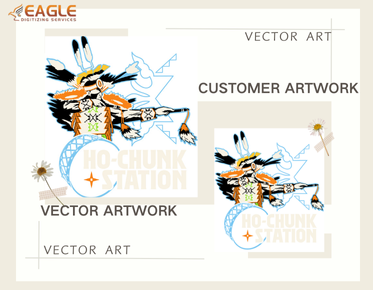Using Vector Files for Screen Printing vs Embroidery – What’s the Difference?
In the world of design and printing, vector files have become an indispensable asset. They are used across various mediums from screen printing to embroidery. However, the application and characteristics of vector files in these two domains vary significantly. Understanding these differences can help you make the most of these files for your specific needs.
Understanding Vector Files
Vector files are digital images that are created using mathematical formulas. Unlike raster images which pixelate when scaled, vector images can be scaled infinitely without losing quality. This property makes them ideal for logos, icons, and other designs that require precision and scalability. Popular file formats for vector images include SVG, EPS, AI, and PDF.
Vector Files in Screen Printing
Screen printing is a process that involves pressing ink through a stenciled mesh screen to create a printed design. Vector files are preferred in screen printing for several reasons. Firstly, they maintain their quality regardless of the size. This ensures crisp and clean images on materials of various dimensions. Moreover, vector files facilitate easy color separation, which is crucial in screen printing, allowing each color in the design to be isolated for individual processing【4:0†source】.
Advantages of Vector Files in Embroidery
Embroidery involves creating patterns on fabric using threads. Here, vector files play a different role. They are converted into stitch files that guide the embroidery machines on how to stitch the design. The precision and quality of vector images are critical here as they ensure that the design replicates accurately on the fabric, maintaining the intricacies and details of the original design.
Comparing the Two: Key Differences
When comparing screen printing and embroidery, the primary difference lies in the application process. Screen printing typically benefits from the scalability and color separation features of vector files. On the other hand, embroidery utilizes the precision of vectors for accurate stitch conversions. Additionally, while vector files for screen printing are often concerned with defining clear, block colors, embroidery requires attention to how threads of different colors blend and layer to replicate the design.
The Role of Technology in Enhancing Vector File Utility
Advancements in technology have significantly enhanced the utility of vector files in both screen printing and embroidery. With superior vector software and digital embroidery machines, converting intricate designs into high-quality embroidery or print outputs has never been easier. These technological advancements allow for greater creativity and flexibility in design, catering to both small-scale artisans and large businesses【4:1†source】.
Choosing the Right Service Provider
Whether you're utilizing vector files for screen printing or embroidery, selecting the right service provider is crucial. Companies like Eagle Digitizing offer comprehensive conversion services that guarantee high-quality outputs. They specialize in converting any image into professional vectors and excel in both print and embroidery applications, making them a trusted partner for businesses aiming to elevate their branding materials【4:0†source】.
The Future of Vector Files in Design
As design trends continue to evolve, the role of vector files in screen printing and embroidery is set to expand even further. With the integration of AI and machine learning in design technologies, the potential applications and capabilities of vectors are limitless. This progression offers exciting possibilities and challenges for designers and businesses alike, opening up avenues for innovation and differentiation in the market. It raises intriguing questions about the future adaptations of these technologies and their impact on traditional and digital design landscapes.


